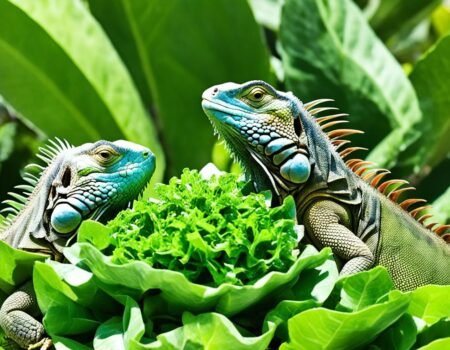Have you ever witnessed the astonishing transformation of a tiny hatchling into a majestic adult? Iguanas, with their vibrant colors and unique characteristics, have always fascinated me. Their growth journey is a testament to the wonders of nature, and understanding it can help us provide the best care for these awesome creatures.
From the moment they hatch from their eggs, iguanas embark on an incredible adventure of development and growth. It is fascinating to observe how their physical features, behavior, and needs change as they progress through various stages.
Let me take you on this captivating journey of iguana growth stages, from adorable hatchlings to impressive adults. Together, we will uncover the mysteries of their development, gaining insights that can enhance our understanding and appreciation for these incredible reptiles.
Key Takeaways:
- Understanding the growth stages of iguanas is essential for providing appropriate care.
- Iguanas undergo remarkable physiological and behavioral changes as they mature.
- Proper housing, nutrition, and management contribute to the healthy growth of iguanas.
- The life cycle of iguanas involves distinct stages, from hatchlings to juveniles, yearlings, subadults, and finally, adults.
- By learning about their growth journey, we can develop a deep connection with these fascinating creatures.
Factors Affecting Iguana Growth
Understanding the factors that influence iguana development is essential for successful captive rearing. Several key factors directly impact the growth and well-being of these reptiles. By optimizing their nutrition, temperature, housing conditions, and overall care, we can ensure healthy growth and development.
Nutrition: Providing a balanced and appropriate diet is crucial for iguana growth. These herbivorous creatures require a variety of fruits, vegetables, and plant matter to meet their nutritional needs. Feeding iguanas a diet rich in nutrients, such as leafy greens and calcium, promotes healthy bone development and overall growth.
Temperature: Maintaining the correct temperature is vital for iguana growth. As ectothermic animals, they rely on external sources of heat to regulate their body temperature. Maintaining a suitable temperature gradient within their enclosure allows them to thermoregulate effectively, promoting proper growth and metabolism.
Housing Conditions: Providing a spacious and enriching environment is essential for iguana growth. They need an enclosure that allows for climbing, basking, and exploration. Creating a habitat that mirrors their natural habitat, complete with branches, hides, and basking spots, stimulates their physical and mental well-being, enhancing their growth.
Overall Care: Proper care and attention contribute significantly to iguana growth. Regular veterinary check-ups, appropriate handling, and stress reduction techniques are vital for their well-being. Ignoring signs of distress or neglecting their care can hinder their growth and development.
Considering these iguana growth factors and ensuring their optimization enhances the chances of successful captive rearing and the overall development of these fascinating reptiles.
Life Cycle of the Green Iguana
The life cycle of the green iguana is a fascinating journey that encompasses several stages of development. From the moment the gravid female lays her clutch of fertile eggs after mating, to the hatchlings emerging from their eggs, and the subsequent growth and maturation of these reptiles, each stage is filled with unique characteristics and milestones.
It all begins with the gravid female iguana laying her eggs. These eggs then undergo an incubation period of approximately 90 days before they hatch and the young iguanas make their entry into the world. The hatchlings are small and fragile, marking the beginning of their journey towards adulthood.
After their hatching, iguanas enter the juvenile stage. This stage spans from one week after hatching to around seven months old. During this time, the young iguanas undergo significant growth and development, gradually acclimating to their environment and strengthening their bodies.
At around twelve months of age, iguanas transition to the yearling stage. They are no longer hatchlings but have not yet reached full maturity. The yearling stage is a critical period for their development, setting the foundation for their future growth and behavior.
As iguanas continue to age, they enter the subadult stage between 18 to 22 months. This stage is characterized by further physical and behavioral transformations as the iguanas prepare themselves for adulthood. While they possess some adult characteristics, they are not yet fully mature.
Most iguanas reach full maturity between three to four years of age, marking the transition to young adulthood. At this stage, their growth has slowed down, and they attain their adult size and reproductive capabilities. It is during this time that they become established members of their ecosystems, contributing to the reproduction and survival of their species.
Check out stages!!
| Life Stage | Age |
|---|---|
| Juvenile | 1 week to 7 months |
| Yearling | 12 months |
| Subadult | 18 to 22 months |
| Young Adult | 3 to 4 years |
Understanding the life cycle of the green iguana is essential for providing optimal care, as each stage requires specific attention and adjustments. By recognizing the different stages in iguana development, we can ensure their well-being and support their growth into healthy and mature adults.
Breeding and Reproduction
When it comes to iguana breeding and reproduction, adult males and females play their respective roles with fascinating behaviors. Male iguanas display courtship behaviors to attract females and initiate the mating process. These behaviors include head bobbing, dewlap extension (expanding the colorful throat pouch), and even changes in skin color to communicate their intentions.
Once a female iguana has been successfully courted, she will begin the process of egg-laying. Female iguanas will dig nests in suitable locations, often returning to the same nest several times to ensure it meets their standards. This careful and selective nesting behavior is an essential part of iguana reproduction. The female will lay her eggs in the nest, which typically consists of a clutch of 20-70 eggs, depending on the species.
“The nesting behavior of female iguanas is truly remarkable. They are very picky about finding the right spot and preparing an ideal nest for their eggs. It’s a testament to their innate maternal instincts.”
After the eggs are laid, the incubation period begins. The eggs are left to develop undisturbed, generally lasting around 90 to 120 days. Temperature plays a crucial role in determining the gender of the hatchlings. Higher temperatures often result in more female hatchlings, while lower temperatures lead to more males. This unique characteristic highlights the intricate nature of iguana mating behavior.
Finally, when the incubation period is complete, hatchlings emerge from their eggs with the assistance of an egg tooth, a small temporary structure that they use to break through the shell. This marks the beginning of their independent journey from hatchling to the subsequent stages of iguana growth and development.
Growth Rate and Size
One of the fascinating aspects of iguanas is their rapid growth rate during their first year of life. These remarkable creatures can grow at an average rate of around 3/4 inch per month, displaying significant physical development.
By the time iguanas reach the age of two, they can already measure up to 0.9 meters (3 feet) in length. As they continue to mature, adult iguanas can reach impressive lengths of 1.3 to 2 meters (4 to 6 feet), showcasing their majestic size and structure.
The size of iguanas varies based on their sex. Male iguanas tend to be larger and more robust, weighing between 4 to 8.5 kilograms. On the other hand, female iguanas are comparatively smaller, with a weight range of 1.5 to 4.5 kilograms.
Iguanas’ growth rate, size, and weight are influenced by various factors, including genetics, nutrition, and environmental conditions. Providing optimal care and a suitable habitat for these magnificent reptiles can ensure their healthy development.
| Iguana Size | Weight (kg) |
|---|---|
| Males | 4 – 8.5 |
| Females | 1.5 – 4.5 |
Ensuring the appropriate growth rate and size of iguanas requires a balanced diet, proper housing, and regular monitoring of their overall well-being. Understanding these aspects of their development allows us to provide the best care possible for these incredible creatures.
Housing and Enclosures
When it comes to housing iguanas, providing the right environment is essential for their health and well-being. As reptiles, iguanas rely on external sources of heat and light to regulate their body temperature, so it’s important to create a setup that mimics their natural habitat.
Firstly, iguana enclosures should be spacious enough to allow for movement and exercise. A standard rule is to provide at least 1.5 times the length of the iguana for the enclosure’s height and around twice the length for the width. This gives them enough room to climb, explore, and stretch their legs.
Temperature and humidity are crucial factors in iguana housing. The enclosure should have temperature gradients to provide both warm and cool areas, allowing the iguana to regulate its body temperature as needed. A basking spot with a heat source, such as a heat lamp or ceramic heat emitter, should be provided for thermoregulation. The ambient temperature in the enclosure should range from 80°F to 90°F (27°C to 32°C) during the day, with a drop to 70°F to 80°F (21°C to 27°C) at night.
Humidity levels should be maintained between 60% and 80% to ensure proper shedding and respiratory health. Regular misting or the use of a reptile humidifier can help maintain the humidity within the desired range.
In addition to temperature and humidity, iguanas need various structures and furnishings in their enclosure. Providing climbing structures, such as branches or rocks, allows them to exercise their natural behaviors. Basking platforms or shelves positioned at different heights give them options to thermoregulate. Hide boxes or caves provide them with a sense of safety and privacy.
Proper housing and enclosures play a crucial role in the mental and physical well-being of iguanas. It’s important to create a comfortable and stimulating environment that meets their specific needs. By offering an appropriate habitat, we can help ensure the overall health and happiness of these amazing reptiles.
Feeding and Nutrition
When it comes to feeding your iguana, it’s important to understand their unique dietary needs. As herbivores, iguanas thrive on a diet that consists primarily of fruits, flowers, leaves, and vegetables. Providing a varied and balanced diet is crucial for their overall health and well-being.
**Iguana feeding** should be done regularly, taking into consideration their age and size. Young iguanas may require pureed or chopped food to make it easier for them to consume and digest. As they grow older, they can transition to eating larger pieces of food.
Incorporating **iguana nutrition** supplements into their diet is also essential. Calcium and vitamin supplements help ensure that your iguana’s nutritional requirements are met. These supplements can be added to their food or provided in the form of reptile-specific supplements.
The **proper diet for iguanas** should also include specific types of greens and vegetables that provide essential nutrients. Dark leafy greens such as kale, collard greens, and mustard greens are excellent choices. Other suitable vegetables include carrots, bell peppers, and squash.
Tip: Avoid feeding your iguana foods that are high in oxalates, such as spinach and rhubarb, as these can interfere with calcium absorption.
It is important to prepare their food appropriately. Wash fruits and vegetables thoroughly to remove any pesticides or residues. Chop or shred the food into small, bite-sized pieces that are easy for your iguana to eat. Providing a variety of textures and flavors helps keep them interested in their food.
Sample Meal Plan for an Iguana
Here is a sample meal plan for your iguana to give you an idea of how to incorporate different food items into their diet:
| Day | Morning | Afternoon | Evening |
|---|---|---|---|
| Monday | Kale and bell peppers | Collard greens and carrots | Blueberries |
| Tuesday | Mustard greens and butternut squash | Broccoli and green beans | Papaya |
| Wednesday | Swiss chard and sweet potatoes | Zucchini and peas | Mango |
Remember to always provide fresh water for your iguana to ensure they stay hydrated. Regularly monitor their eating habits and adjust their diet as needed. If you have any concerns about **iguana feeding** or need further guidance, consult a veterinarian with experience in reptile care.
Common Diseases and Health Issues
Ensuring the health and well-being of your iguana is essential for their overall longevity and happiness. Unfortunately, like any living creature, iguanas can be susceptible to various diseases and health issues. By understanding and recognizing these common ailments, you can take proactive measures to prevent and manage them.
Malnutrition and its Effects
One of the most prevalent health problems faced by iguanas is malnutrition. Improper diet and feeding habits can lead to a lack of essential nutrients, resulting in weakened immune systems and various health complications. Overfeeding certain foods, such as high-fat content foods or those lacking in essential vitamins and minerals, can lead to deformed bones and obesity.
“A balanced diet is crucial for maintaining the overall health of your iguana.”
To ensure your iguana receives the necessary nutrients, provide a diverse diet consisting of fruits, vegetables, and foliage. Additionally, vitamin and calcium supplements may be recommended by your veterinarian to ensure your iguana’s dietary needs are met.
Egg Retention and Reproductive Issues
Female iguanas are particularly prone to reproductive health issues, such as egg retention. This condition occurs when eggs fail to pass through the reproductive tract, leading to discomfort and potential complications. Calcium deficiencies are often the underlying cause.
To mitigate the risk of egg retention, it is crucial to provide your female iguana with a well-balanced, calcium-rich diet. Regular veterinary check-ups and ultrasounds can help detect any potential issues early on and facilitate appropriate treatment.
Respiratory Infections
Iguanas can also suffer from respiratory infections, especially when housed in environments with poor ventilation, high humidity, or low temperatures. Common symptoms of respiratory infections in iguanas include coughing, wheezing, nasal discharge, and lethargy.
To prevent respiratory infections, ensure proper ventilation in your iguana’s enclosure and maintain appropriate temperatures and humidity levels. Regularly cleaning and disinfecting the enclosure can also help minimize the risk of infection.
Parasitic Infections
Parasitic infections, such as intestinal parasites and mites, can pose a significant threat to the health of your iguana. These parasites can cause weight loss, lethargy, digestive issues, and skin problems.
“Regular veterinary check-ups can help detect and treat parasitic infections in your iguana.”
Regular veterinary check-ups and fecal examinations are essential for identifying and treating parasitic infections. Additionally, maintaining a clean and hygienic environment for your iguana can help prevent reinfestation.
By staying vigilant and providing proper care, nutrition, and regular veterinary check-ups for your iguana, you can help prevent and manage common diseases and health issues. Recognizing the signs and symptoms early on is key to ensuring prompt intervention and the best possible outcome for your scaly companion.
Behavior and Social Interactions
When it comes to iguanas, understanding their behavior and social interactions is crucial for their proper care and management. These reptiles are naturally solitary animals, preferring to establish their own territories.
During the breeding season, however, male iguanas can become territorial and display aggressive behaviors towards other males. This is a natural instinct driven by the need to compete for mates and ensure reproductive success.
Social interactions among iguanas are generally limited, and clashes between individuals are rare in the wild. The availability of basking sites, such as rocks or tree branches, allows iguanas to establish their own territories without much competition. This helps reduce the chances of aggressive encounters.
In captivity, proper planning and management are crucial to prevent aggressive behaviors and injuries. Providing enough space within enclosures, along with proper hiding spots and basking areas, can help minimize stress and potential conflicts among iguanas.
Proper planning and management are crucial to prevent aggressive behaviors and injuries in captive iguanas.
The Importance of Proper Socialization
While iguanas are primarily solitary creatures, early socialization is important for maintaining their overall well-being in captivity. Exposure to different environments, people, and other animals at a young age can help iguanas develop a positive association with their surroundings.
This socialization process not only helps prevent aggressive behaviors but also facilitates easier handling and reduces stress when it comes to veterinary visits or other necessary interactions.
When introducing multiple iguanas into the same enclosure, it’s essential to closely monitor their behavior and ensure adequate resources, such as food, water, and shelter, are available to minimize competition and territorial disputes.
Understanding Iguana Aggression
Iguana aggression can manifest in various ways, including tail whipping, biting, displays of dominance, and territorial defense. It’s crucial to recognize the signs of aggression and take appropriate measures to address it.
Aggressive behaviors in iguanas can often be triggered by environmental stressors, such as inadequate temperatures or lighting, overcrowding, or lack of suitable hiding spots. Identifying and addressing these underlying causes can help alleviate aggression and promote a more peaceful living environment for these reptiles.
Aggressive Behaviors and Possible Causes
| Aggressive Behavior | Possible Causes |
|---|---|
| Tail whipping | Feeling threatened or cornered |
| Biting | Defending territory or feeling provoked |
| Displays of dominance | Establishing hierarchy or competing for resources |
| Territorial defense | Protecting their territory from intruders |
By understanding iguana behavior, social interactions, and the potential causes of aggression, we can provide a safe and enriching environment for these captivating reptiles. Proper planning, socialization, and attentive management are key to fostering peaceful coexistence among iguanas, both in the wild and in captivity.
Captive Rearing and Management
When it comes to the captive rearing of iguanas, proper housing, diet, and care are essential for ensuring their well-being. As responsible caretakers, we must create suitable enclosures, offer a balanced diet, and conduct regular health checks to support their growth and development.
Housing: Creating the ideal environment for captive iguanas involves providing spacious enclosures that mimic their natural habitat. The enclosure should have enough space for the iguana to move, climb, and bask comfortably. Adding climbing structures, basking spots, and hiding places will enhance their mental and physical well-being. It’s also important to maintain appropriate temperature and humidity levels within the enclosure to ensure their comfort.
Diet: Proper nutrition is vital for the health and growth of captive iguanas. As herbivores, iguanas require a varied diet consisting of fresh fruits, flowers, leaves, and vegetables. It’s important to provide a balanced diet that meets their specific nutritional needs. Including calcium and vitamin supplements in their diet can help prevent common deficiencies. Feeding iguanas regularly and providing properly prepared food promotes their digestion and overall well-being.
Health Checks: Regular health checks are crucial for managing the health of captive iguanas. This includes monitoring their weight, checking for signs of illness or injury, and assessing their overall condition. It’s recommended to consult with a reptile veterinarian who specializes in iguanas to ensure comprehensive care. Seeking professional advice will help identify any potential health issues and develop appropriate management plans.
Managing captive iguanas goes beyond meeting their basic needs. Establishing proper management routines is key to their long-term care. Implementing daily, weekly, monthly, seasonal, and annual care routines will help ensure the overall well-being of these fascinating reptiles.
Conclusion
Understanding the growth stages of iguanas is crucial for their proper care and management. From hatchlings to adults, iguanas go through different physiological and behavioral changes. By providing optimal conditions and meeting their specific needs, we can ensure the healthy growth and development of these fascinating reptiles.
Throughout their life cycle, iguanas undergo a remarkable transformation. From the moment they hatch as vulnerable hatchlings, they embark on a journey of growth and discovery. As juveniles, they explore their surroundings, learning to climb, bask, and hunt for food. Through their subadult and adult stages, they continue to mature physically and mentally, fully embracing their roles as resilient and adaptable creatures.
Key takeaways about iguana growth include the importance of nutrition, temperature, and overall care to support their development. Providing a balanced diet rich in fruits, flowers, and vegetables, along with appropriate heating and spacious enclosures, is essential. Regular veterinary check-ups and proactive management help prevent health issues and ensure their well-being.
FAQ
What are the different stages in the life cycle of iguanas?
The life cycle of iguanas consists of several stages, including hatching, juvenile, yearling, subadult, and young adult. Full maturity is typically reached at 3 to 4 years old.
How do iguanas breed and reproduce?
Iguana breeding involves adult males and females coming together for mating. Males display courtship behaviors, while females lay eggs in nests they dig. The incubation period for the eggs is around 90 to 120 days.
How fast do iguanas grow and how big do they get?
Iguanas experience rapid growth during their first year, with growth rates of around 3/4 inch per month. By the age of two, they can reach a length of 0.9 meters (3 feet). Adult iguanas can grow up to 1.3 to 2 meters (4 to 6 feet) in length.
What are the housing requirements for iguanas?
Proper housing for iguanas includes providing artificial heat or sunlight, spacious enclosures with appropriate temperature and humidity levels, as well as climbing structures, basking spots, and hiding places.
What should I feed my iguana and how often?
Iguanas are herbivores and should be fed a variety of fruits, flowers, leaves, and vegetables. Young iguanas may require pureed or chopped food, while adults can eat larger pieces. Feeding should be done regularly, and a balanced diet with calcium and vitamin supplements is important for their digestion.
What are common diseases and health issues in iguanas?
Malnutrition and improper care can lead to health issues in iguanas. Overfeeding certain foods can cause deformed bones, while a lack of calcium can result in egg retention or death in females. Regular veterinary check-ups and a proper diet are essential for preventing and managing common diseases in iguanas.
How do iguanas behave and interact socially?
Iguanas are solitary animals that prefer to establish their territories. During the breeding season, males can become territorial and display aggressive behaviors toward other males. Social interactions are limited, and clashes between individuals are rare in the wild. Proper planning and management are important in captivity to prevent aggressive behaviors and injuries.
How should I rear and manage iguanas in captivity?
Captive rearing of iguanas involves providing appropriate housing, diet, and care. This includes creating suitable enclosures, offering a balanced diet, and conducting regular health checks. Proper management routines on a daily, weekly, monthly, seasonal, and annual basis are important for maintaining the health and growth of captive iguanas.









No Comment! Be the first one.